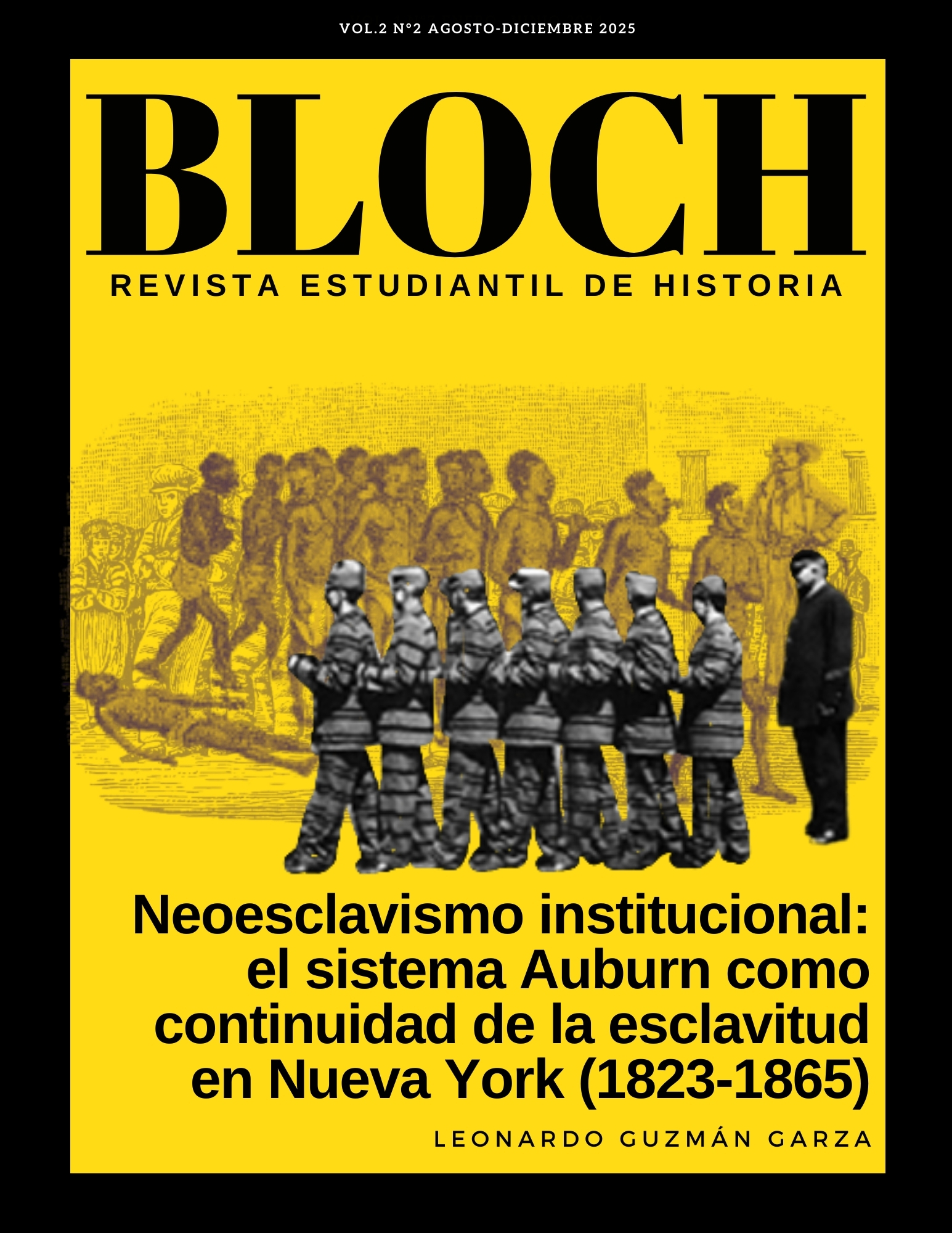Neoesclavismo institucional: el sistema Auburn como continuidad de la esclavitud en Nueva York (1823-1865)

Published 2025-09-29
Keywords
- sistema Auburn,
- penitenciaría,
- Nueva York,
- esclavitud,
- neoesclavitud
How to Cite
Copyright (c) 2025 Leonardo Guzmán Garza

This work is licensed under a Creative Commons Attribution 4.0 International License.
Abstract
Abstract: The aim of this research is to analyze the continuity of slave practices in New York after the official abolition of slavery in 1827, through a study of the Auburn penitentiary system in New York. After an extensive review of primary and secondary sources, it is argued that although New York outlawed slavery, it established a penitentiary system that implemented neo-slavery practices, such as the exploitation of inmate labor, severe punishments, the dehumanization of bodies, and ultimately, their exhibition for the enrichment of the State. In reality, slave practices were not eliminated in New York but rather transformed and perfected. Likewise, practices of exclusion toward certain social groups were institutionalized. This research seeks to illustrate these ideas.
The primary sources used in this study include: a newspaper note published in 1858 on the death of an African American prisoner named More, found in the Digital Collection of the New York Public Library; a map of the Auburn prison; and a document on the abolition of slavery in New York, dating from 1827. On the other hand, the bibliography consulted consists of texts by authors such as Ashley T. Rubin, Nick Fesette, Dario Melossi, Massimo Pavarini, Michel Foucault, and Denise Green. The main contribution of this work is to demonstrate that the Auburn system was not a more humane alternative to slave punishment, but rather one of its continuities, implemented within a reformist legal framework.
Downloads
References
- New York State Archives
- The Fay Family Page. Genealogies.
- The New York Public Library. Digital Collections.
- Harper's weekly: a journal of civilization. (New York: Harper' s Weekly Co., 1857-1916).
- Foucault, Michel. Los anormales. México: Fondo de Cultura Económica, 2007.
- Herre, Ralph. The history of Auburn prison from the beginning to about 1867. The Pennsylvania State College. Department of History, 1950.
- Melossi, Darío y Massimo Pavarini. Cárcel y fábrica. Los orígenes del sistema penitenciario (siglos XVI-XIX). Madrid: Siglo XXI editores, 1980.
- Trujillo, Jorge. Entre la celda y el muro: Rehabilitación social y prácticas carcelarias en la penitenciaría jalisciense "Antonio Escobedo" (1877-1911). El Colegio de Michoacán, 2007.
- Fesette, Nick. “Auburn Prison and Carceral Modernity: A Performance History”. Modernity Print+, Volume 3, Cycle 1, 4-13, 2018. https://modernismmodernity.org/forums/posts/auburn-prison
- Follis, Luca. Democratic punishment and the Archive of Violence: Publicity, Prisions and Corporal Excess in Antebellum New York. Lancaster University. Disponible en: https://www.academia.edu/9725474/Democratic_Punishment_and_the_Archive_of_Violence_Punishment_Publicity_and_Corporal_Excess_in_Antebellum_New_York?auto=download
- Green, Denisse & Nancy Breen. “Silk Mania in the Auburn Prison”, 1841-1844. The Journal of the Costume Society of America, 155-166, 2021. https://doi.org/10.1080/03612112.2021.1877975
- Kemble, Frances. Journal of a residence on a georgian plantation 1838-1839. Library of the St. Charles Borromeo Seminary. Disponible en: https://www.gutenberg.org/cache/epub/12422/pg12422-images.html
- Sánchez, Cristóbal. “La aparición y evolución de los sistemas penitenciarios”. Anales de Derecho, 31, 2014. 139–179. Recuperado a partir de https://revistas.um.es/analesderecho/article/view/185251
- Seward, William. On the irrepressible conflict. Delivered at Rochester, NY, October 25, 1858. http://www.nyhistory.com/central/conflict.htm
- Roberts, Leonard. “The historic roots of american prison reform: a story of progress and failure”. Journal of correctional education, volume 36, issue 3, 106-109, september 1985.
- Rubin, Ashley. “Three waves of american prison development, 1790-1920”. Punishment and Incarceration: A global perspective. Sociology of Crime, Law and Deviance, Volume 19, 139-158, 2014. Disponible en: Three Waves of American Prison Development, 1790–1920 | Emerald Insight
- ________________ "History of the Prison". The Handbook of Social Control, 277-292, 2019. Disponible en: https://scholar.google.es/citations?view_op=view_citation&hl=es&user=M48X9Z4AAAAJ&citation_for_view=M48X9Z4AAAAJ:kNdYIx-mwKoC
- Gómez Mejía, Ana. “Conflictos sociales en Querétaro a finales del siglo XVIII, década de 1790-1800.” Tesis de licenciatura, Universidad Autónoma de Querétaro, 2009. https://ri-ng.uaq.mx/handle/123456789/5029
- Herrera, Verónica. “Un patrocinio para la vida eterna. La familia Medina Picazo.” Tesis de maestría, Universidad Nacional Autónoma de México, 2020. https://hdl.handle.net/20.500.14330/TES01000802749
